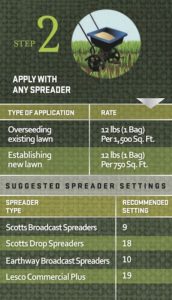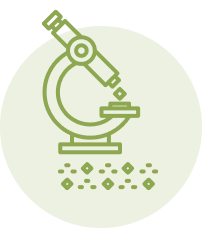Earth Science lawn products are designed to be both effective and easy to use. With Earth Science, you can maximize the return on your efforts and increase the amount of time you can enjoy the lawn.
Each application of Earth Science lawn products is as easy as 1, 2, 3!
Step 1 – Apply
Apply Earth Science lawn products with any spreader. Use the recommended spreader settings and application rate. See the back of the product bag for details or view the product page on this site.

Step 2 – Clean Up
Return any unused product to the bag and store for later use. Sweep any product landing on paved surfaces, driveways, sidewalks, or streets onto the lawn.
Step 3 – Enjoy!
Our products are safe for people and pets right after application, for immediate enjoyment of the lawn.
Earth Science Timeline for Total Lawn Care
Each season brings opportunities for effective and efficient lawn care. By taking the right actions in the proper season, it is easy to maintain a vigorous, healthy lawn with a minimum of effort.
Spring into Action
Spring is the time to lay the foundation for a healthy lawn.
Mineral Soil Amendments
- Early spring is a great time of year to apply mineral soil amendments to keep the soil healthy and soil pH in the proper range.
- Earth Science Fast Acting Gypsum® helps improve soil structure and water infiltration, making it an ideal amendment for any type of soil. Gypsum also provides calcium and sulfur, essential plant nutrients, to the soil.
- Maintaining proper soil pH (5.5 to 7.0 for most grasses) is important for good growth. A soil test can determine soil pH.
- For soils that have an overly high pH (alkaline soil), use Earth Science Fast Acting Sulfur® to reduce the soil pH.
- For soils with an overly low pH (acidic soil), use Earth Science Fast Acting™ Lime to naturally increase the soil pH.
Spring Fertilization Fundamentals
- Fertilize cool season grasses in spring, once growth resumes.
- Fertilize warm season grasses in late spring, once temperatures warm up enough for growth to begin.
Summer Success
Choose a summer lawn care strategy based on grass type
Lawn care needs in summer vary based on the type of lawn, with distinct differences between cool season lawns and warm season lawns.
- Cool season grasses generally do not need fertilization in summer. Instead of fertilizer, Earth Science Fast Acting Iron® can provide a green-up to summer lawns without stimulating growth.
- Warm season grasses benefit from summer fertilization, as they will actively grow during the summer season. Make one or two fertilizer applications in summer for warm season grasses.
- Water as needed
- Mow as needed
Fall Fundamentals
Fall care is key to future success
Fall is a critical period for lawn care and provides key opportunities for improving lawn success the following season.
- For cool season grasses, fall is the most important time to fertilize. If you fertilize just once a year, make it in fall. Fall feeding helps lawns to build strong, deep root systems, improving performance once growth resumes in spring.
- Fall is also the optimal time to overseed cool season lawns. Overseeding helps turn thin, weak grass into vigorous, thick lawns. Warm season lawns can be overseeded with cool season grasses to provide fall and winter color.
For more detailed information on the Earth Science approach to lawn care, see our Smart Lawn Care article.




